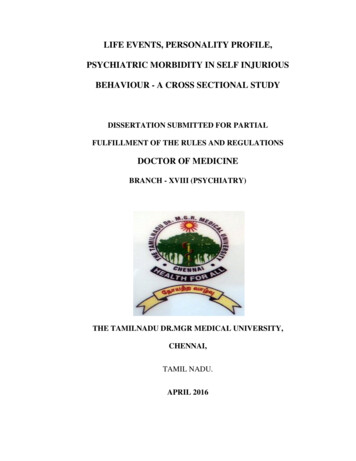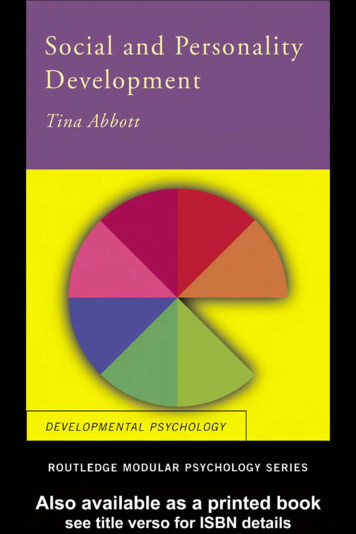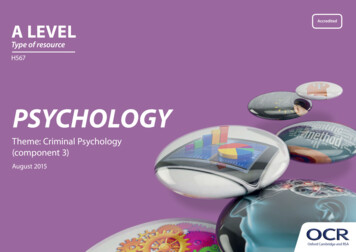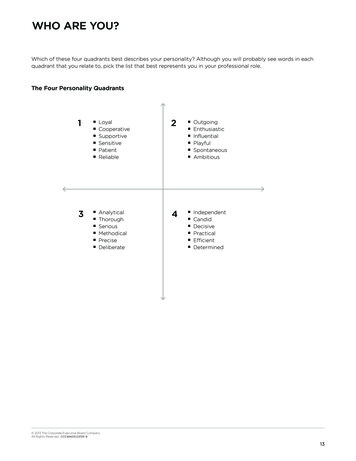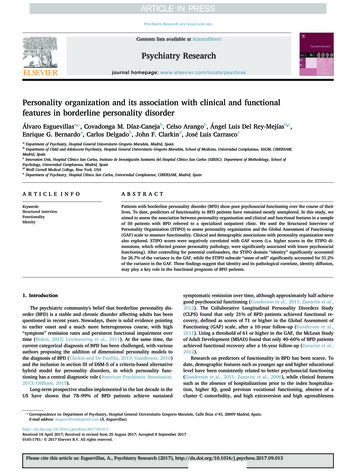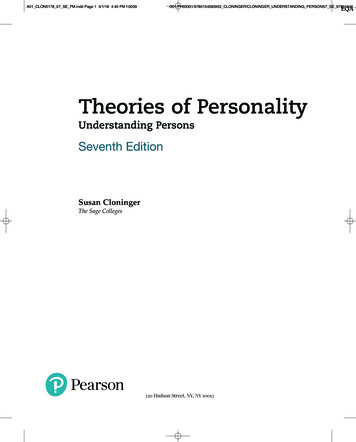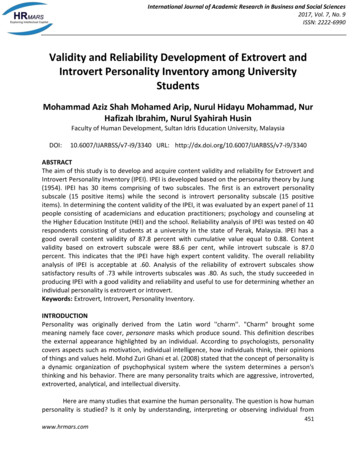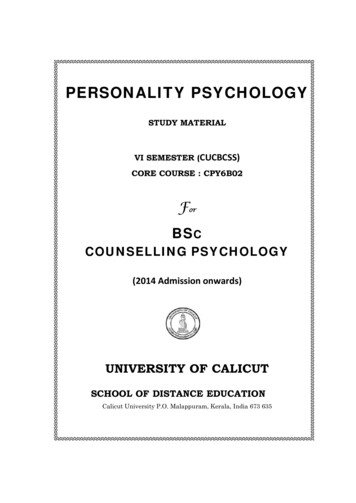
Transcription
PERSONALITY PSYCHOLOGYSTUDY MATERIALVI SEMESTER (CUCBCSS)CORE COURSE : CPY6B02ForBSCCOUNSELLING PSYCHOLOGY(2014 Admission onwards)UNIVERSITY OF CALICUTSCHOOL OF DISTANCE EDUCATIONCalicut University P.O. Malappuram, Kerala, India 673 635
School of Distance EducationUNIVERSITY OF CALICUTSCHOOL OF DISTANCE EDUCATIONSTUDY MATERIALVI Semester (CUCBCSS)BSC COUNSELLING PSYCHOLOGY(2014 Admission onwards)CORE COURSE: CPY6B02PERSONALITY PSYCHOLOGYPrepared by :Sri. ELDHOSE N JResearch Scholar,Department of Psychology,University of Calicut.Layout: Computer Section, SDE ReservedPersonality PsychologyPage 2
School of Distance EducationCONTENTSPAGE NO.Module IPsychoanalytic Approach-5Module IITrait Theories-27Module IIIHumanistic Perspectives-36Module IVEastern and Positive Perspectives-44Personality PsychologyPage 3
School of Distance EducationPersonality PsychologyPage 4
School of Distance EducationMODULE 1: PSYCHOANALYTIC APPROACHIntroductionAs a human being each one of us shows certain specific patterns of thinking, feeling andacting. They represent who we are and provide the basis of our interaction with other individuals. Ineveryday life we often find people who are called “aggressive”, “jolly”, “happy” and so on. Theseare impressions of people which we carry with us and use while interacting with them. It is in thissense that we frequently employ the word ‘personality’. The study of personality has also attractedthe attention of psychologists and they have developed various theories of personality. Also, theyhave developed certain tools to assess people’s personality. The personality related information isused in selecting people for various jobs, giving guidance to people in the need of psychologicalhelp, and mapping their potential. Thus the study of personality contributes to different areas ofhuman behaviour. This chapter will help you learn about different aspects of personality.Contributions of Neo Freudians in brief: Jung, Adler, Horney, Erich Fromm. Every one of us sharesmany things with others. However, apart from commonalities we also find that people are differentin the way they appear and behave. The study of personality deals with the issue of humanindividuality. It has attracted the attention of common man as well as academic psychologists.Concept of PersonalityThe term personality is used in a number of ways including the apparent features of a person.However, psychologists use it to refer to the characteristic pattern of thinking, feeling and acting. Bycharacteristic pattern we mean the consistent and distinctive ways our ideas, feelings and actionsare organized. When we talk about personality we usually refer to the totality or whole of theperson. Thus, the enduring pattern expressed by the person in various situations is the hall mark ofpersonality. Interestingly the theories of personality go beyond the literal meaning of “personality”which stands for large masks used by actors in ancient Greek drama. Contrary to this the personalitytheorists view ‘personality’ as the essence of the person. It is a person’ s “true” inner nature. Theunique impression that a person makes on others is equally important in understanding personality.However the concept of personality has been defined by psychologists in many ways and it is thetheoretical perspective or position which directs our attention to particular aspects of personality.Allport (1961) personality is the - dynamic organization within the individual of thosepsycho-physical systems that determine his unique adjustment to his environment. It means thatpersonality- resides within the individual and these systems are woven into an organization.Personality is not static but dynamic, the organizational pattern determines the kind anddegree of adjustment of the individual to his environment, and this adjustment-pattern is unique tothe individual.Personality PsychologyPage 5
School of Distance EducationPersonality is the more or less stable and enduring organisation of a person‘scharacter, temperament, intellect, and physique that determine his unique adjustment to hisenvironment.Personality usually refers to the distinctive patterns of behaviour (including thoughtsand emotions) that characterize each individual‘s adaptations to the situations of his life or herlife.Personality is usually defined as individual‘s unique and relatively stable patterns ofbehaviour, thoughts and emotions. (Baron, 1993).Understanding personality has proved to be a difficult and challenging task. It’s so complexthat no single theory is able to cover the total personality. The different theories approach thestructure and functioning of personality from different positions. There are many theories ofpersonality each provides different answers about the way they treat the issues about personalityfunctioning. In particular, they provide different explanations about the role ofconscious/unconscious factors, determinism/freedom in functioning, role of early experience, role ofgenetic factors, uniqueness/universality etc. In the present lesson you will learn about fourmajortheoretical perspectives of personality. They include psychoanalytic, trait, humanisticandsocial-cognitive perspectives.THE PSYCHOANALYTIC PERSPECTIVEFounded by Sigmund Freud, this theory emphasizes the influence of the unconscious, theimportance of sexual and aggressive instincts, and early childhood experience on a person. Thistheory has been very influential not only in psychology but also in literary circles, art, psychiatryand films. Many of Freud’ s ideas have become part and parcel of every day usage. Freud started hiscareer as a neurologist. His theory developed in the course of his observations of his patients, as wellas, self-analysis. He used free association to help his patients recover forgotten memories.Freud discovered that mind is like an iceberg and we have limited consciousawareness.Freud proposed that psychological forces operate at three levels of awareness: Conscious level: The thoughts, feelings, and sensations that one is aware of atthe presentmoment. Preconscious level: It contains information of which one is not currently aware,however,they can easily enter conscious mind. Unconscious level: It consists of thought, feelings, wishes, drives etc. of whichwe are notaware. It, however, influences our conscious level of activity. Freud thought thatunconscious material often seeks to push through to the consciouslevel in a disguisedPersonality PsychologyPage 6
School of Distance Educationmanner. It may be in a distorted manner and or it may take asymbolic form. Interpretation ofdreams and free association were used for analysisof the three levels of awareness.Personality StructureFreud believed that human personality emerges due to a conflict between ouraggressive andpleasure seeking biological impulses and the internalized socialrestraints against them. Thus,personality arises in the course of our effort to resolvethe conflicts. To this end he proposed threestructures which interact with eachother: Id, Ego and Super Ego. Let us learn about these structures:Id: It is the unconscious, irrational part of personality . It is the primitive part immunetomorality and demands of the external world. It operates on the pleasure principle.It seeks immediatesatisfaction.Ego: It is involved with the workings of the real world. It operates on the realityprinciple.It is the conscious, and rational part of personality that regulates thoughtsand behaviors. It teachesthe person to balance demands of external world andneeds of the person.Super Ego: It is the internal representation of parental and societal values. Itworks as thevoice of conscience, that compels the ego to consider not only thereal but also the ideal. It judgesone’ s behaviors as right or wrong, good or bad.Failing up to moral ideals bring about the shame,guilt, inferiority and anxiety in theperson.Personality DevelopmentOn the basis of case-history of patients, Freud reached at a conclusion thatpersonalitydevelopment occurs through a sequence of psychosexual stages. Inthese stages the Id’ s pleasureseeking tendency focuses on different areas of body .Psychogenetic model of developmentFreud (1900/1953) proposed that child development proceeds through a series of stages related tophysical development, and that adult personality is influenced by how crises are resolved at eachstage. Each stage is named after an erogenous zone, or area of the body that can experience pleasurefrom the environment. Excessive gratification or frustration at any one stage can result in thefixation of libido and subsequent disruption to normal personality development.1. Oral stage (birth to 18 months) At the beginning of this stage children are highly dependenton their mothers and derive pleasure from sucking and swallowing. Freud suggested thatchildren who become fixated at this early oral stage derive pleasure in adulthood fromactivities such as overeating, smoking, drinking and kissing. He referred to such people asoral-incorporative or oral-ingestive. Later in the oral stage, children begin to cut teeth andexperience pleasure from biting and chewing. Fixation at this later part of the stage results inPersonality PsychologyPage 7
School of Distance Educationchewing objects and nail-biting in adulthood, as well as being sarcastic and critical. Freudcalled those fixated at this level oral-aggressive or oral-sadistic.2. Anal stage (18 months to three years) At this stage pleasure is gained from the expulsion andretention of faeces. This is also a stage at which children start to explore their environmentbut experience control and discipline from their parents. According to Freud, fixation at thisstage may result in people being messy and generous – anal expulsive characters, or beingmean and orderly – anal-retentive characters.3. Phallic stage (three to five years) It is at the phallic stage that children discover pleasurefrom touching their genitals. They also become aware that they are in competition withsiblings and their father for their mother’s attention.Freud believed that boys become increasingly attached to their mother at this stage andresent the presence of their father. These feelings produce anxiety or fear of punishment from thefather – or castration anxiety. In order to protect themselves against this anxiety, boys identify withtheir fathers. Freud called boys’ desire for their mother the Oedipus complex, because of thesimilarity to the ancient Greek play in which Oedipus unwittingly kills his father and marries hismother.Freud argued for a rather different process in girls. He believed that girls reject their motherat the phallic stage, owing to resentment that they have been born without a penis. They then feelincreasing attraction to their father, who has the penis they lack. Penis envy is not resolved untilwomen have a male child, thereby symbolically obtaining a penis. This process was also namedafter an ancient Greek play – Electra. In Greek mythology, Electra was famous for her devotion toher father, and sought revenge against her mother for her father’s death. Fixation at the phallic phaseand failure to resolve the Electra or Oedipus complex was viewed as the cause of sexual and/orrelationship difficulties in later life.4. Latency stage (six to twelve years) According to Freud, personality is formed by the end ofthe phallic stage, and sexual impulses are rechanneled during the latency period intoactivities such as sport, learning and social activities.5. Genital stage (13 years to adult) As young people approach the age of reproductive ability,they begin to focus their libido, or sexual energy, towards the opposite sex. If the earlierpsychosexual stages have been successfully negotiated, the individual should now begin toform positive relationships with others.Table1 shows these stages.Personality PsychologyPage 8
School of Distance EducationDefense MechanismsThe Ego has to perform a difficult duty of mediating between the instinctual demandsof Idand moral position of Super Ego. The Ego tries to solve the problem and if arealistic solution orcompromise is not possible it indulges in distorting thoughts orperception of reality through certainprocesses called defense mechanisms. Todefend or safeguard ourselves, we use technique calleddefense mechanism. Theseare also called Adjustment Mechanisms. Some of the key mechanismsare givenbelow:Defining Defense Mechanism Freud proposed the structural hypothesis, which divides themind into three forces – id, ego, and super- ego. He believed that both normal and abnormalbehavior result from interactions among the id, ego, and super ego, among which the ego tends todistort or simply deny a reality that would arouse unbearable anxiety. Freud called this tactic adefense mechanism, and as long as it works, the anxiety will be experienced unconsciously.Freud's assumption about human behaviuorFreudian theory assumes that abnormalbehavior stems from events in the individual's past and that it occurs in response to unconscious anduncontrollable impulses.Is defense mechanism indispensible to human life? Freud believed that both normal andabnormal behavior result from interactions among the id, ego, and superego. At times, either the idor the superego will threaten to overwhelm the ego's control, resulting in unacceptable feelings orbehavior. In response to this threat, the person experiences anxiety. Most anxiety is not experiencedPersonality PsychologyPage 9
School of Distance Educationconsciously but is held in check by defense mechanism. Though often adaptive, overuse of defensemechanism may interfere with thought processes and everyday functioning.A healthy adult has the ego strength to balance conflicting demands by the id, and thesuperego. When the ego experiences too much conflict, it is weakened. This produces rigid behaviorpatterns, called neurosis. In extreme cases, the ego collapses and adaptive functioning ceases, acondition known as psychosis. Accordingly, defense mechanism is indispensible for people toprevent such psychosis.Types of defense mechanism and examples1. primary defense mechanism repression ; unacceptable id impulses are pushed down into theunconscious and thereby robbed of their power to disturb us consciously. (e.g., a girl who issexually attracted to her father will simply remove this intolerable thought from herconsciousness. It may come up in her dreams, but in disguised form; and once she wakes up,the dreams, too, are likely to be repressed). denial ; Whereas repression is the refusal to recognize an internal reality or source ofanxiety, such as a taboo impulse, denial is the refusal to acknowledge an external source ofanxiety. (e.g., a woman who has been diagnosed as terminally ill may go on planning alengthy trip to be taken when she is well again). It is usually resorted to by children or bypeople facing a very serious threat (e.g., terminal illness or the death of a loved one)2. secondary defense mechanism projection ; unacceptable impulses are first repressed, then attributed to others. thus, aninternal threat is converted into an external threat. (e.g., a man whose self-esteem isthreatened by his own preoccupation with money may accuse others of being moneyhungry). This relieves his own moral anxiety and simultaneously enables him to throw theguilt onto others. displacement : It involves a transfer of emotion. However, what is switched is not the sourcebut the object of the emotion. Afraid to display or even to experience certain feelings againstwhoever has aroused them, the person repress the feelings. Then, when the opportunityarises, he or she transfers them to a safer object and releases them. (e.g., a man may spendthe day suffering humiliations at work for which he cannot retaliate; then he goes home,discovers that his son has failed to take out the trash, and on that pretext gives the boy aterrible dressing down). rationalization : proving one's behavior is justifiable, rational and thus worthy of self andsocial approval. (e.g., we need t make ourselves "looks good.") reaction formation : a person who engages in reaction formation represses the feelings thatare arousing anxiety and then vehemently professes exactly the opposite. (e.g., someone whoPersonality PsychologyPage 10
School of Distance Educationclaims to be disgusted by sexual promiscuity may be demonstrating a reaction formationagainst his or her own sexual impulses). sublimation : the transformation and expression of sexual or aggressive energy into moresocially acceptable forms, differs from all other defense mechanism in that it can be trulyconstructive. (e.g., The skill of a great surgeon may represent a sublimation of aggressiveimpulses).regression : Unable to deal with its anxiety, the ego simply abandons the sceneof the conflict, reverting to an earlier, less threatening stage. (e.g, a regressed adult may bereduced to a babbling, helpless creature who has to be fed and toileted like a baby).A healthy adult has the ego strength to balance conflicting demands by the id, and thesuperego. When the ego experiences too much conflict, it is weakened. This produces rigid behaviorpattern, called neurosis. And, in extreme cases the ego collapses and adaptive functioning ceases, acondition known as psychosis, and thus becomes an abnormal behavior. Freud’s daughter, Anna,defined many of the defense mechanism such as repression, denial, displacement, rationalization,isolation, reaction formation and so forth.What’s wrong with ‘abnormal’ person? It has been found to be quite difficult to distinguishbetween a normal and abnormal person. In this direction a number of view points have beenadvanced. However, in contemporary psychology, the standard for distinguishing between ‘normal’and ‘abnormal’ runs as follows;(1) Subjective standard Social norms(value): A person violating his social norms is seen asabnormal. But they can differ widely between cultures. Statistical Rarity(fact): Abnormality is anysubstantial deviation from statistically calculated average(e.g., Stanford-Binet IQ test). But, in thiscase, a person whose I.Q. is above or below this average is to be considered as abnormal. Personaldiscomfort(fact): If people are content or feel comfort with his lives, they are normal, while peopledistressed over them are abnormal. But it makes people the judges of their own normality, ratherthan subjecting them to the judgment of the society or diagnostician. Maladaptive Behavior(fact orvalue): If people are able to meet the demands of their everyday lives (e.g., hold down a job, dealwith friends and family, pay the bills on time, and the like.), they are normal, if not, abnormal. Butadaptation depends on time and surroundings. If a person with the fear of flying has a job thatrequires long-distance travel, his behavior could be considered maladaptive unlike ordinary people.(2) Objective standard – A combined standard(facts and values) However much disputesurrounds the definition of abnormal behavior, it should be rest on a combined standard, puttingfacts and values together that most societies identify the same categories of behavior as indicative ofmental disorder(abnormality). Maher and Maher point out there are four basic categories. 1.Behavior that is harmful to the self or that is harmful to others without serving the interests of theself. 2. Poor reality contact – for example, beliefs that most people do not hold or sensoryPersonality PsychologyPage 11
School of Distance Educationperceptions of things that most people do not perceive. 3. Emotional reactions inappropriate to theperson’s situation. 4. Erratic behavior – that is, behavior that shifts unpredictably.Topographic model of the psycheFreud (1905/53b) argued that the mind is divided into the conscious, the preconscious andthe unconscious.According to Freud, the conscious is the part of the mind that holds everything you arecurrently aware of. The preconscious contains everything you could become aware of but are notcurrently thinking about. The unconscious is the part of the mind that we cannot usually becomeaware of. Freud saw the unconscious as holding all the urges, thoughts and feelings that might causeus anxiety, conflict and pain. Although we are unaware of them, these urges, thoughts and feelingsare considered by Freud to exert an influence on our actions.Structural model of the psycheAlongside the three levels of consciousness, Freud (1923/62, 1933) developed a structuralmodel of personality involving what he called the id, the ego and the superego.According to Freud, the id functions in the unconscious and is closely tied to instinctual andbiological processes. It is the primitive core from which the ego and the superego develop. As thesource of energy and impulse it has two drives:Eros – a drive for life, love, growth and self preservationThanatos – a drive for aggression and deathThese drives, or instincts, are represented psychologically as wishes that need to be satisfied.External or internal stimulation creates tension, which the id seeks to reduce immediately. This iscalled the ‘pleasure principle’ – the idea that all needs have to be satisfied immediately, avoidingpain and seeking pleasure, regardless of external conditions. The id is directly linked to bodilyexperience and cannot deal effectively with reality. As such it is limited to two forms of response –reflex responses to simple stimuli (e.g. crying with pain), or primary process thinking (hallucinatoryimages of desired objects), which provides a basic discharge of tension.According to Freud, primary process thinking does not actually meet the fundamental needof the organism – just as dreaming of water does not satisfy thirst – so a second structure, the ego,focuses on ensuring the id’s impulses are expressed effectively in the context of the real world. Theego, as a source of rationality, conforms to the ‘reality principle’ – delaying the discharge of energyfrom the id until an appropriate object or activity can be found. The ego engages in secondaryprocess thinking. It takes executive action on the part of the ego to decide which actions areappropriate, which id impulses will be satisfied, how and when. But the ego has no moral sense,only practical sense. It is a third structure, the superego, which, according to Freud, provides moralguidance, embodying parental and societal values.Personality PsychologyPage 12
School of Distance EducationThe superego has two sub-systems: conscience, or images of what is right and what deserves punishment – this is the basis forguilt; and ego ideal, or images of what is rewarded or approved of – this is the basis for pride.Violation of superego standards can generate anxiety over loss of parental love, which isexperienced as guilt. By the same token, Freud viewed a ‘weak’ superego as the cause of selfindulgence and criminality.According to Freud, the ego mediates between id impulses, superego directives and the realworld. Conflicts in this process can lead to three types of anxiety: neurotic anxiety – that the id will get out of control; moral anxiety – that past or future behaviour is immoral; orreality anxiety – about objective dangers in the environment.When anxiety cannot be dealt with by realistic methods, the ego calls upon various defencemechanisms to release the tension.Defence mechanisms deny, alter or falsify reality. As they operate unconsciously, they arenot immediately obvious to us or to other people. Defence mechanisms include: displacement – substituting an acceptable behaviour for an anxiety-inducing one;projection – projecting the threatening thing on to others; reaction formation – creating an attitude opposite to the one that you hold;intellectualization – transforming emotional or affective drives into rational intentions; andRegression – reverting to modes of behaviour from childhood in order to avoid conflict.Jung’s Analytical Theory—The Structure and the Dynamics of Personality CharacteristicsCarl Jung (1875–1961) was one of the first prominent analysts to break away from Freud.Jung worked with Freud in the early stages of his career, and was viewed by him as the disciple whowould carry on the Freudian tradition. But Jung saw humans as being guided as much by aims andaspirations as by sex and aggression. To distinguish his approach from classic psychoanalysis, Jungnamed it analytical psychology (1951). A basic assumption of his theory is that personality consistsof competing forces and structures within the individual that must be balanced. Unlike Freud, heemphasized conflicts between opposing forces within the individual, rather than between theindividual and the demands of society, or between the individual and reality.Carl Jung whispered that people are very intricate beings who possess a diversity ofopposing qualities, such as introversion and extraversion, masculinity and femininity, andrational and irrational drives.Personality PsychologyPage 13
School of Distance EducationBiography of Carl JungCarl Jung was born in Switzerland in 1875, the oldest surviving child of an idealisticProtestant minister and his wife. Jung's early experience with parents (who were quite opposite ofeach other) almost certainly influenced his own theory of personality. Soon after getting hismedical degree he became acquainted with Freud's writings and eventually with Freud himself.Not long after he traveled with Freud to the United States, Jung became disenchanted with Freud'spansexual theories, broke with Freud, and began his own approach to theory and therapy,which he described analytical psychology. From a critical midlife crisis, throughout which healmost lost get in touch with reality, Jung appeared to become one of the leading thinkers of the20th century. He died in 1961 at age 85.Levels of the PsycheJung saw the human psyche as being divided into a conscious and an unconsciouslevel, with the latter further subdivided into a personal and a communal unconscious. Conscious: Images sensed through the ego are said to be conscious. The ego therefore represents the conscious side of personality, and in the psychologically mature individual,the ego is secondary to the self.Personal Unconscious: The unconscious refers to those psychic images not sensed throughthe ego. Some unconscious processes flow from our personal experiences, but othersstem from our ancestors' experiences with universal themes. Jung divided the unconsciousinto the personal unconscious, which contains the complexes (emotionally toned groups of related ideas) and the communal unconscious, or ideas that are beyond our personalexperiences and that originate from the repeated experiences of our ancestors.Communal Unconscious: Communal unconscious images are not inherited ideas, butrather they refer to our innate tendency to react in a scrupulous method whenever ourpersonal experiences stimulate an inherited predisposition toward action. Contents of the communal unconscious are described archetypes.Archetypes: Jung whispered that archetypes originate through the repeated experiencesof our ancestors and that they are expressed in certain types of dreams, fantasies,delusions, and hallucinations. Many archetypes acquire their own personality, and Jungrecognized these through name. One is the persona-the side of our personality that we showto others. Another is the shadow-the dark side of personality. To reach full psychologicalmaturity, Jung whispered, we necessity first realize or accept our shadow. A secondhurdle in achieving maturity is for men to accept their anima, or feminine side, and forwomen to embrace their animus, or masculine disposition. Other archetypes contain thegreat mother (the archetype of nourishment and destruction); the wise old man (thearchetype of wisdom and meaning); and the hero, (the image we have of a conqueror whoPersonality PsychologyPage 14
School of Distance Educationvanquishes evil, but who has a single fatal flaw). The most comprehensive archetype is theself; that is, the image we have of fulfillment, completion, or perfection. The ultimatein psychological maturity is self-realization, which is symbolized through the mandala, orperfect geometric figure.Dynamics of PersonalityJung whispered that the dynamic principles that apply to physical energy also apply topsychic energy. These forces contain causality and teleology as well as progression and regression. Causality and Teleology: Jung accepted a middle position flanked by the philosophicalissues of causality and teleology. In other words, humans are motivated both through their past experiences and through their expectations of the future.Progression and Regression: To achieve self-realization, people necessity adapt to boththeir external and internal worlds. Progression involves version to the outside world and theforward flow of psychic energy, whereas regression refers to version to the inner world andthe backward flow of psychic energy. Jung whispered that the backward step isessential to a person's forward movement toward selfrealization.Psychological TypesEight basic psychological types emerge from the union of two attitudes and four functions. Attitudes: Attitudes are predispositions to act or react in a characteristic manner. Thetwo basic attitudes are introversion, which refers to people's subjective perceptions, andextraversion, which designates an orientation toward the objective world. Extravertsare influenced more through the real world than through their subjective perception, whereas introverts rely on their individualized view of things. Introverts and extravertsoften mistrust and misunderstand one another.Functions: The two attitudes or extroversion and introversion can combine with fourbasic functions to form eight general personality types. The four functions are (1)thinking, or recognizing the meaning of stimuli; (2) feeling,
PERSONALITY PSYCHOLOGY STUDY MATERIAL VI SEMESTER (CUCBCSS) CORE COURSE : CPY6B02 For BSC COUNSELLING PSYCHOLOGY (2014 Admission onwards) UNIVERSITY OF CALICUT SCHOOL OF DISTANCE EDUCATION

